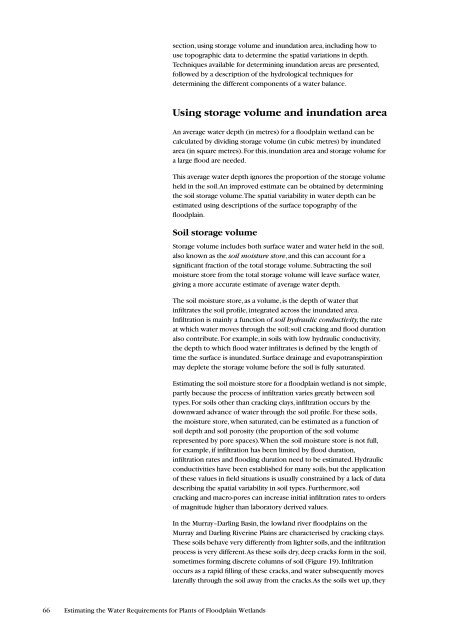Estimating the Water Requirements for Plants of Floodplain Wetlands
Estimating the Water Requirements for Plants of Floodplain Wetlands
Estimating the Water Requirements for Plants of Floodplain Wetlands
You also want an ePaper? Increase the reach of your titles
YUMPU automatically turns print PDFs into web optimized ePapers that Google loves.
section, using storage volume and inundation area, including how touse topographic data to determine <strong>the</strong> spatial variations in depth.Techniques available <strong>for</strong> determining inundation areas are presented,followed by a description <strong>of</strong> <strong>the</strong> hydrological techniques <strong>for</strong>determining <strong>the</strong> different components <strong>of</strong> a water balance.Using storage volume and inundation areaAn average water depth (in metres) <strong>for</strong> a floodplain wetland can becalculated by dividing storage volume (in cubic metres) by inundatedarea (in square metres). For this, inundation area and storage volume <strong>for</strong>a large flood are needed.This average water depth ignores <strong>the</strong> proportion <strong>of</strong> <strong>the</strong> storage volumeheld in <strong>the</strong> soil. An improved estimate can be obtained by determining<strong>the</strong> soil storage volume. The spatial variability in water depth can beestimated using descriptions <strong>of</strong> <strong>the</strong> surface topography <strong>of</strong> <strong>the</strong>floodplain.Soil storage volumeStorage volume includes both surface water and water held in <strong>the</strong> soil,also known as <strong>the</strong> soil moisture store, and this can account <strong>for</strong> asignificant fraction <strong>of</strong> <strong>the</strong> total storage volume. Subtracting <strong>the</strong> soilmoisture store from <strong>the</strong> total storage volume will leave surface water,giving a more accurate estimate <strong>of</strong> average water depth.The soil moisture store, as a volume, is <strong>the</strong> depth <strong>of</strong> water thatinfiltrates <strong>the</strong> soil pr<strong>of</strong>ile, integrated across <strong>the</strong> inundated area.Infiltration is mainly a function <strong>of</strong> soil hydraulic conductivity, <strong>the</strong> rateat which water moves through <strong>the</strong> soil; soil cracking and flood durationalso contribute. For example, in soils with low hydraulic conductivity,<strong>the</strong> depth to which flood water infiltrates is defined by <strong>the</strong> length <strong>of</strong>time <strong>the</strong> surface is inundated. Surface drainage and evapotranspirationmay deplete <strong>the</strong> storage volume be<strong>for</strong>e <strong>the</strong> soil is fully saturated.<strong>Estimating</strong> <strong>the</strong> soil moisture store <strong>for</strong> a floodplain wetland is not simple,partly because <strong>the</strong> process <strong>of</strong> infiltration varies greatly between soiltypes. For soils o<strong>the</strong>r than cracking clays, infiltration occurs by <strong>the</strong>downward advance <strong>of</strong> water through <strong>the</strong> soil pr<strong>of</strong>ile. For <strong>the</strong>se soils,<strong>the</strong> moisture store, when saturated, can be estimated as a function <strong>of</strong>soil depth and soil porosity (<strong>the</strong> proportion <strong>of</strong> <strong>the</strong> soil volumerepresented by pore spaces). When <strong>the</strong> soil moisture store is not full,<strong>for</strong> example, if infiltration has been limited by flood duration,infiltration rates and flooding duration need to be estimated. Hydraulicconductivities have been established <strong>for</strong> many soils, but <strong>the</strong> application<strong>of</strong> <strong>the</strong>se values in field situations is usually constrained by a lack <strong>of</strong> datadescribing <strong>the</strong> spatial variability in soil types. Fur<strong>the</strong>rmore, soilcracking and macro-pores can increase initial infiltration rates to orders<strong>of</strong> magnitude higher than laboratory derived values.In <strong>the</strong> Murray–Darling Basin, <strong>the</strong> lowland river floodplains on <strong>the</strong>Murray and Darling Riverine Plains are characterised by cracking clays.These soils behave very differently from lighter soils, and <strong>the</strong> infiltrationprocess is very different. As <strong>the</strong>se soils dry, deep cracks <strong>for</strong>m in <strong>the</strong> soil,sometimes <strong>for</strong>ming discrete columns <strong>of</strong> soil (Figure 19). Infiltrationoccurs as a rapid filling <strong>of</strong> <strong>the</strong>se cracks, and water subsequently moveslaterally through <strong>the</strong> soil away from <strong>the</strong> cracks. As <strong>the</strong> soils wet up, <strong>the</strong>y66 <strong>Estimating</strong> <strong>the</strong> <strong>Water</strong> <strong>Requirements</strong> <strong>for</strong> <strong>Plants</strong> <strong>of</strong> <strong>Floodplain</strong> <strong>Wetlands</strong>
















